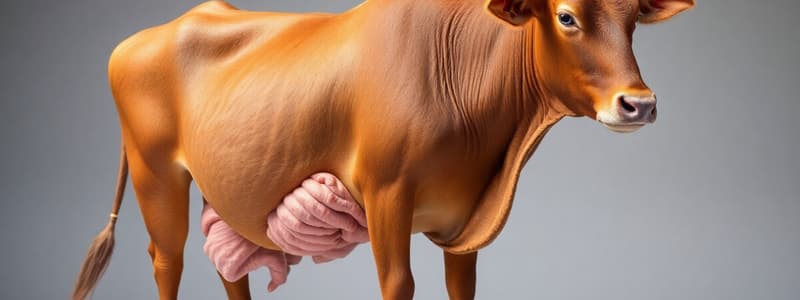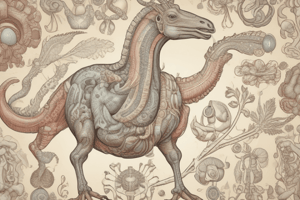Podcast
Questions and Answers
The digestion process in monogastric animals commences in the mouth, involving mechanical breakdown and the enzymatic action of ______.
The digestion process in monogastric animals commences in the mouth, involving mechanical breakdown and the enzymatic action of ______.
saliva
In ruminant digestion, the largest compartment of the stomach is the ______, which houses microorganisms for fermenting plant material.
In ruminant digestion, the largest compartment of the stomach is the ______, which houses microorganisms for fermenting plant material.
rumen
Unlike ruminants, hindgut fermenters like horses rely on the ______ as the primary site for microbial fermentation.
Unlike ruminants, hindgut fermenters like horses rely on the ______ as the primary site for microbial fermentation.
cecum
The avian digestive system includes a unique organ called the ______, which contains grit to aid in grinding food particles due to the absence of teeth.
The avian digestive system includes a unique organ called the ______, which contains grit to aid in grinding food particles due to the absence of teeth.
The 'true' stomach in ruminants, which secretes hydrochloric acid and digestive enzymes, is known as the ______.
The 'true' stomach in ruminants, which secretes hydrochloric acid and digestive enzymes, is known as the ______.
[Blank] is the process in ruminants that involves regurgitation, re-chewing, and re-swallowing of food to improve digestion.
[Blank] is the process in ruminants that involves regurgitation, re-chewing, and re-swallowing of food to improve digestion.
Horses practice limited nutrient absorption from microbial protein because fermentation occurs after the ______ in their digestive system.
Horses practice limited nutrient absorption from microbial protein because fermentation occurs after the ______ in their digestive system.
In poultry, the ______ is a sac-like structure used for food storage and moistening before digestion continues further down the digestive tract.
In poultry, the ______ is a sac-like structure used for food storage and moistening before digestion continues further down the digestive tract.
Enzymes such as pepsin, trypsin and chymotrypsin are classified as ______ because they facilitate the breakdown of proteins into smaller peptides and amino acids.
Enzymes such as pepsin, trypsin and chymotrypsin are classified as ______ because they facilitate the breakdown of proteins into smaller peptides and amino acids.
Absorption of nutrients primarily takes place in the ______, which is characterized by a large surface area due to the presence of villi and microvilli.
Absorption of nutrients primarily takes place in the ______, which is characterized by a large surface area due to the presence of villi and microvilli.
The process of ______ in some hindgut fermenters allows them to obtain additional nutrients, particularly B vitamins and microbial protein, by consuming their own feces.
The process of ______ in some hindgut fermenters allows them to obtain additional nutrients, particularly B vitamins and microbial protein, by consuming their own feces.
Volatile fatty acids (VFAs) are a primary energy source for ruminants, produced during ______ of plant material by microorganisms in the rumen.
Volatile fatty acids (VFAs) are a primary energy source for ruminants, produced during ______ of plant material by microorganisms in the rumen.
The liver produces ______, which is stored in the gallbladder and secreted into the small intestine to emulsify fats, aiding their absorption.
The liver produces ______, which is stored in the gallbladder and secreted into the small intestine to emulsify fats, aiding their absorption.
Birds conserve water by excreting nitrogenous waste as ______, which requires less water for excretion compared to urea in mammals.
Birds conserve water by excreting nitrogenous waste as ______, which requires less water for excretion compared to urea in mammals.
The pancreas secretes enzymes like amylase, lipase, and trypsin into the small intestine to further aid in digestion; ______ specifically helps break down fats into fatty acids and glycerol.
The pancreas secretes enzymes like amylase, lipase, and trypsin into the small intestine to further aid in digestion; ______ specifically helps break down fats into fatty acids and glycerol.
Flashcards
Digestive System Function
Digestive System Function
Breaks down food, absorbs nutrients, and eliminates waste.
Monogastric Animals
Monogastric Animals
Animals with a single-compartment stomach.
Stomach Function (Monogastric)
Stomach Function (Monogastric)
Storage, mixing, and initial protein breakdown in monogastrics.
Small Intestine Function
Small Intestine Function
Signup and view all the flashcards
Bile Function
Bile Function
Signup and view all the flashcards
Ruminant Animals
Ruminant Animals
Signup and view all the flashcards
Rumen Function
Rumen Function
Signup and view all the flashcards
VFAs
VFAs
Signup and view all the flashcards
Omasum Function
Omasum Function
Signup and view all the flashcards
Abomasum Function
Abomasum Function
Signup and view all the flashcards
Rumination
Rumination
Signup and view all the flashcards
Hindgut Fermenters
Hindgut Fermenters
Signup and view all the flashcards
Crop (Avian)
Crop (Avian)
Signup and view all the flashcards
Amylase
Amylase
Signup and view all the flashcards
Lipase
Lipase
Signup and view all the flashcards
Study Notes
- The digestive system breaks down food, absorbs nutrients, and eliminates waste
- Livestock digestive systems vary with the animal's diet
Monogastric Digestive System (e.g., Pigs, Poultry)
- Monogastric animals have a simple, single-compartment stomach
- Digestion starts in the mouth with mechanical breakdown and saliva's enzymatic action
- The stomach stores, mixes, and starts protein breakdown using hydrochloric acid and enzymes like pepsin
- The small intestine is the primary site for enzymatic digestion and nutrient absorption
- The pancreas secretes enzymes like amylase, lipase, and trypsin into the small intestine for digestion
- Bile from the liver (stored in the gallbladder in some) emulsifies fats for absorption
- The large intestine absorbs water and electrolytes, forming feces
- Poultry have a crop for storage and a gizzard, a muscular organ for grinding food
Ruminant Digestive System (e.g., Cattle, Sheep, Goats)
- Ruminants have a four-compartment stomach: rumen, reticulum, omasum, and abomasum
- The rumen, the largest compartment, contains microorganisms (bacteria, protozoa, fungi) that ferment plant material
- Fermentation produces volatile fatty acids (VFAs), a primary energy source
- Microorganisms synthesize essential amino acids and vitamins
- The reticulum, closely linked to the rumen, aids in particle sorting
- The omasum absorbs water and some VFAs
- The abomasum is the "true" stomach, secreting hydrochloric acid and digestive enzymes
- Rumination involves regurgitating, re-chewing, and re-swallowing food to reduce particle size and increase surface area for microbial action
- Fermentation gases (methane, carbon dioxide) are eliminated through eructation
- Ruminants can digest cellulose and complex carbohydrates via microbial fermentation
Hindgut Fermenters (e.g., Horses, Rabbits)
- Hindgut fermenters have a simple stomach, similar to monogastrics
- The large intestine, especially the cecum, is enlarged for microbial fermentation
- Hindgut microbial fermentation produces VFAs, though absorption is less efficient than in ruminants
- Horses don't ruminate; fermentation after the small intestine limits microbial protein absorption
- Some hindgut fermenters (e.g., rabbits) practice coprophagy (eating feces) for extra nutrients, especially B vitamins and microbial protein
Avian Digestive System
- Avian species have unique digestive adaptations, lacking teeth and needing efficient processing
- The crop is a sac for food storage and moistening
- The proventriculus is the glandular stomach, secreting hydrochloric acid and pepsin
- The gizzard is a muscular organ with grit to grind food particles
- The small intestine is the main site for nutrient absorption, like in monogastrics
- Ceca are paired pouches at the junction of the small and large intestines, where some fermentation occurs
- The cloaca is a common chamber for digestive, urinary, and reproductive tracts
- Birds excrete uric acid as their primary nitrogenous waste, conserving water
Comparative Aspects
- Ruminants' complex digestive systems are adapted for fibrous plant material
- Monogastrics are suited for diets rich in digestible carbohydrates and proteins
- Hindgut fermenters use fibrous feeds but are less efficient than ruminants
- Digestive efficiency relies on feed composition, processing, and animal age/health
Digestive Enzymes
- Amylase breaks down starch into sugars, secreted by salivary glands and pancreas
- Proteases (pepsin, trypsin, chymotrypsin) break down proteins into peptides and amino acids; pepsin from the stomach, trypsin and chymotrypsin from the pancreas
- Lipase breaks down fats into fatty acids and glycerol, secreted by the pancreas
- Cellulase breaks down cellulose into glucose, produced by microorganisms in the rumen and hindgut, not by animals
- Lactase breaks down lactose into glucose and galactose, secreted by the small intestine
Absorption
- Absorption mainly happens in the small intestine, which has a large surface area from villi and microvilli
- Nutrients move across the intestinal epithelium into the bloodstream or lymphatic system
- Water is mainly absorbed in the large intestine
Waste Elimination
- Undigested food, bacteria, and metabolic wastes are excreted as feces
- Mammals eliminate feces through the anus
- Birds eliminate feces through the cloaca, along with uric acid
Factors Affecting Digestion
- Feed Composition: The type and quality of feed influence digestibility and nutrient availability
- Feed Processing: Grinding, pelleting, or cooking can improve digestibility
- Microbial Population: A healthy and diverse microbial population is essential for ruminant and hindgut digestion
- Animal Age/Health: Digestive efficiency may be reduced in young or sick animals
Studying That Suits You
Use AI to generate personalized quizzes and flashcards to suit your learning preferences.




